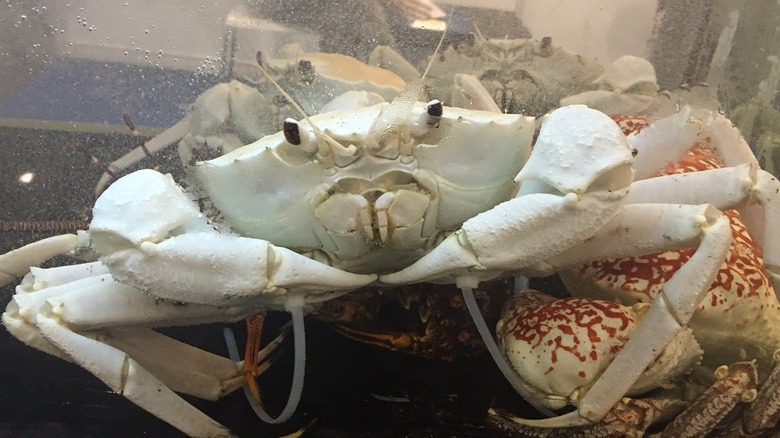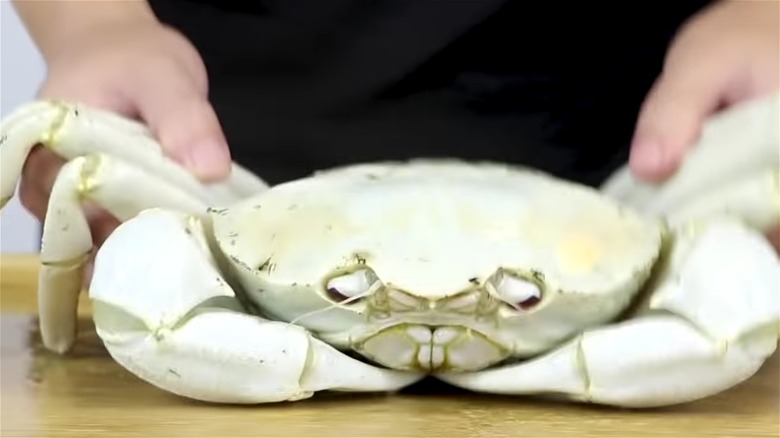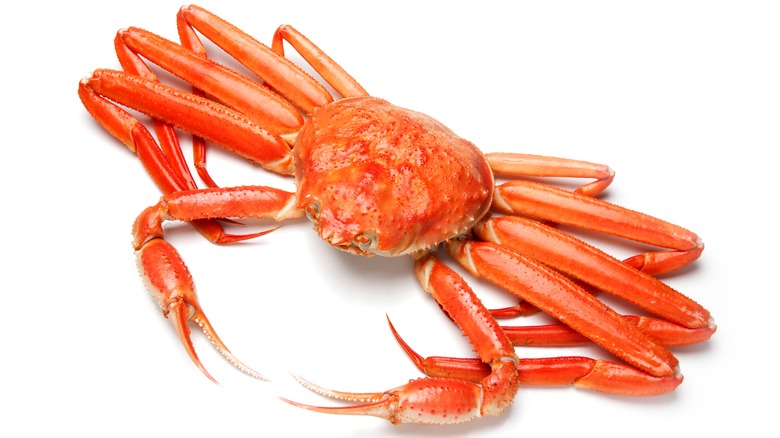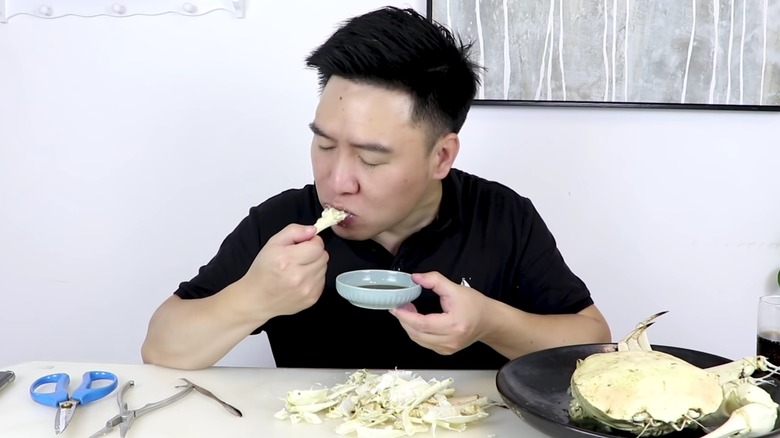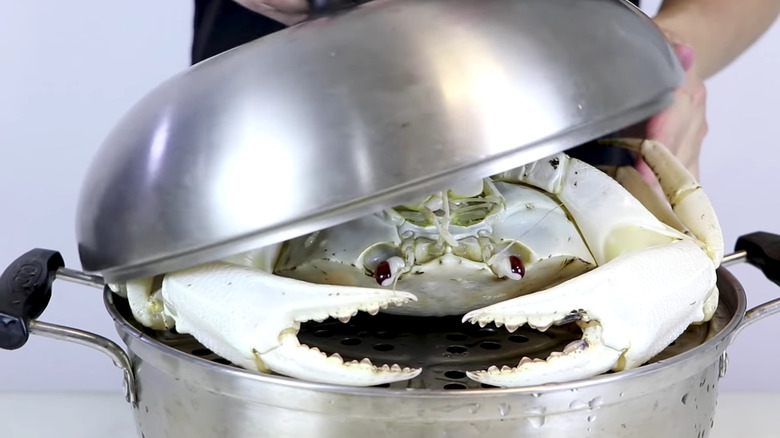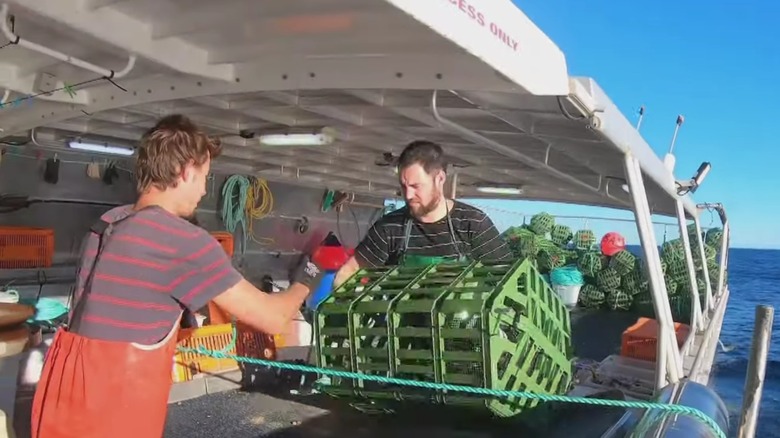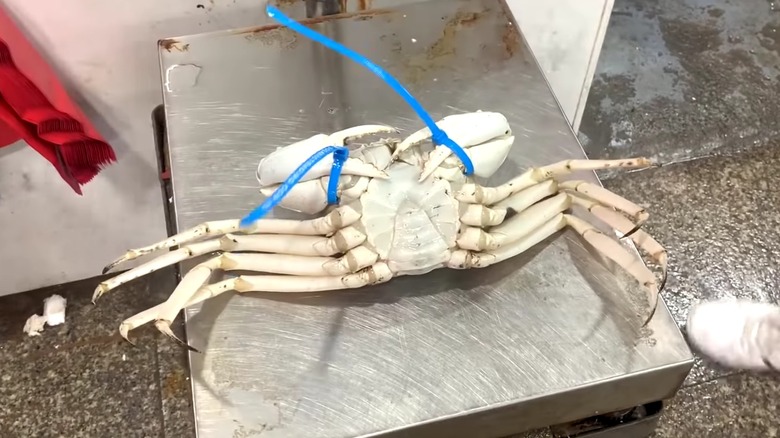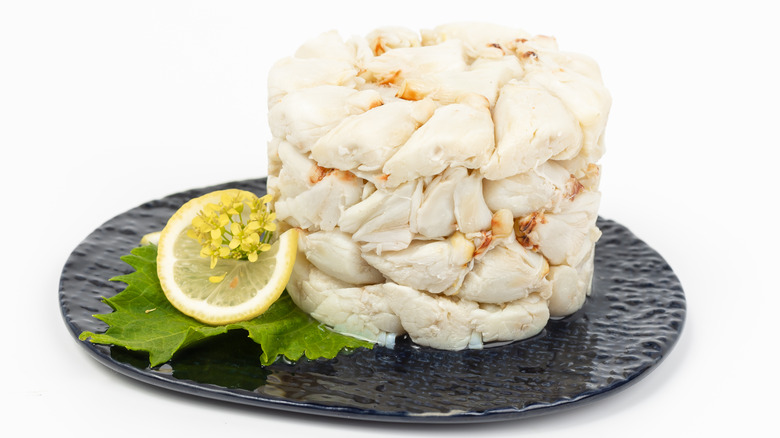What Exactly Are Crystal Crabs And What Do They Taste Like?
Crystal crabs (Chaceon albus) are a breed of crab found in the waters off Australia's western coast. These striking animals are known for both their appearance and taste. As a result, they are often used as a centerpiece for banquets, especially in China where the crustacean is widely celebrated. Thanks to their physical characteristics and scarcity, crystal crabs are among the most highly sought-after crustaceans in the world; with less than 200 tons of crystal crab being caught every year, they cost around $300 AUD per crab.
Like many other crab varieties, crystal crabs are a versatile and highly enjoyable food, boasting a moreish sweet meat that is used in a variety of dishes. What's more, crystal crabs are a healthy protein source that are caught using minimally impactful methods. While almost impossible to find in the United States, crystal crabs should be eaten whenever someone is given the chance. They are as gourmet as crabs get — and we're here to give you all the details on them.
What are crystal crabs?
Crystal crabs are found at depths between 1,500 to 4,000 feet, making them a deep-sea crab. At such depths the water's temperature hardly changes. This means that, unlike many other crab breeds, crystal crabs do not have a seasonally driven mating period. Instead, mating occurs year round. Fishing of them does too, although strict limits are in place to prevent the small population from being overexploited. So valuable is the crystal crab population that other conservation projects, involving the use of underwater camera monitoring systems, are also in use.
Visually, the most obvious feature of crystal crabs is their size; the crabs can grow up to 4.4 pounds over their 30 year lifespan. This considerable size ensures that crystal crabs are a hugely popular banquet food, as fishery director Glen Bosman explained to ABC News. "Our crab is primarily sold, more than 95 per cent, into the Chinese markets and it's used effectively as a banquet," he said. "The crab sits in the middle of the table, is broken up, and then shared by a number [of] people because of its size."
Like many other breeds, crystal crabs boast eight legs and two claws. At this size, that provides ample meat for several people. Another visually appealing aspect of crystal crabs is the white color of their exoskeleton. Unlike other crabs, this exoskeleton does not redden during cooking, making them all the more striking when brought to the table.
Crystal crab vs. Alaska snow crab
In Australia, crystal crabs are often called snow crabs, due to their white carapace. This may lead some people to confuse them with another variety, the Alaska snow crab. As the name suggests, the Alaska snow crab is not found off the coast of Australia, but that of Alaska. This isn't the only way snow crabs are markedly different from crystal crabs. They're also much smaller; on average Alaska snow crabs only weigh a pound. What's more, Alaska snow crabs are found in water that's less than 650 feet deep. And, like many other crab breeds, they turn bright red when cooked.
Alaska snow crabs are also much more widely available than crystal crabs, with the total allowable catch often exceeding 20 million pounds. These large catch volumes, and the geographic proximity of the fishery to the United States' mainland, means Alaska snow crab is much easier for Americans to purchase than crystal crab. However, poor fishery management and climate change have led to an almost total collapse in Alaska snow crab populations. Thankfully, such a collapse has not yet been seen in crystal crabs. Many authorities, including the Marine Stewardship Council, are working to ensure it never does.
What do crystal crabs taste like?
Crystal crabs have been hailed as the best tasting crab in the world by numerous chefs, including the founder of Noma, Rene Redzepi. Redzepi, who served crystal crab meat alongside an egg yolk cured in fermented kangaroo as part of his Noma Down Under series, fell for the crab for the same reasons many other chefs have: its inherently sweet flavor and firm, succulent texture.
These characteristics make the crab extremely well-suited to serving alongside minimal accompaniments. At Si Paradiso, a well-loved restaurant located in Perth, for example, half crystal crabs have been served with lashings of chili-infused butter. That being said, the sweet meat can also stand up to strong ingredients such as ginger, and be used to make complex dishes, as Redzepi highlighted so masterfully.
Further distinctions can be made between how crystal crab's brown and white meat are used. As with many other types of crab, the darker, more flavorful meat is best used among a host of other ingredients while the white is best eaten alone. Chef Charlotte Langley highlighted this in an interview with the Marine Stewardship Council. "I keep it simple with the white meat to make the most of its luscious bite," she said. "Whereas I love to fold the darker meat into a rich seafood stew or a salad with jicama (a Mexican root vegetable), jalapeno and some creme fraiche and melon."
How to cook crystal crab
Although larger than some breeds, crystal crabs are cooked in much the same way as any other crab. Typically, they're boiled or steamed; these delicate cooking processes ensure that the meat does not become overcooked and that its flavor is not obscured by the tastes imparted by processes such as smoking. That being said, there is no right or wrong way to cook crystal crab. Neil Dorrington, a seafood industry representative, explained this to WAFIC, saying, "Crab is easy to cook and eat. It marries well with a variety of flavors and is often served with chilli and or ginger. Have fun and experiment with ingredients. It isn't hard to cook with seafood — you just have to practice — and taste test along the way!"
Given the large size of crystal crabs, boiling and steaming times may be considerably longer than those used for smaller crabs, and can last up to 20 minutes. More experimental cooks might want to separate the legs from the crab and cook these via an alternative means, such as grilling. Some people even smoke crab legs. In this way, one crab can result in a variety of flavors and textures. The meat can also be easily picked and used to make a huge variety of dishes from seafood cocktails to crab fritters.
Where to buy crystal crab
Much of the crystal crab that's caught off the coast of Australia is exported to China. Most of what's not exported to China is often sold to Chinese seafood markets located in Australia or a select number of Australian seafood restaurants that serve the crustacean. This means that crystal crab is extremely difficult for Americans to find and enjoy, especially as seafood-centric restaurants in the United States predominantly focus on selling local varieties, such as king crab.
While its difficult to find a stateside restaurant serving crystal crab, it's even harder to find crystal crab for sale in markets and shops. Even famous seafood markets including both Fulton Fish Market and Pike Place Fish Market do not stock crystal crab. This suggests that Americans' best hope of enjoying the rare, luxurious crustacean is finding it on the menu of a premiere seafood restaurant. That being said, the chances of this happening are extremely slim.
Nutritional information about crystal crabs
All types of crab, crystal crabs included, are known to be highly nutritious, thanks to their high concentration of omega-3 polyunsaturated acids. These essential fats play a vital role in the creation and maintenance of cells and have been directly linked with healthy, regularly beating hearts. What makes consuming these fatty acids all the more important is the fact that the body cannot make them; they must be ingested.
Aside from fatty acids, crystal crabs are also a fantastic source of protein which is used, among other things, to build and repair the body's muscle tissues. In terms of minerals, crystal crabs contain high amounts of selenium, which the body uses as part of the DNA making process. Add to this the low fat, low carbohydrate nature of crystal crab meat, and it's not difficult to see why so many people view this crab as a fantastic addition to any balanced diet.
How to store crystal crab
Although you'll probably never come across it, dead and raw crystal crab should not be bought. Richard Stavis, CEO of a wholesale seafood company, explained why to Epicurious: "Never buy dead raw crab, because there are enzymes within the body that turn the meat very mushy very quickly."
Instead, the crabs should be purchased while still alive, or customers should pay for packages of pre-cooked meat. In both of these instances, the fridge should be used for storage. Live crabs should be kept in a bowl — or crisper drawer — lined with damp towels. It is advisable to kill and eat these live crabs as soon as possible. Pre-cooked crab meat can be kept in the fridge for two days, as long as it's stored in an airtight container. All pieces of shell should be removed before storing the pre-cooked crab meat, as these can harbor potentially harmful bacteria.
Finally, cooked crab meat can be frozen for up to three months in an airtight container. The crab should be taken from the freezer and placed in the fridge the day before you want to use it. This will give it ample time to gradually defrost. Speed up this process by leaving the crab at room temperature and you risk damaging both its texture and flavor.
